The results of the specialists’ and scientists’ researches. Рубрика в журнале - Nanotechnologies in Construction: A Scientific Internet-Journal
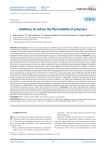
Additives to reduce the flammability of polymers
Статья научная
Introduction. This review article provides data on additives used to reduce the flammability of polymer compositions. It is shown that not individual substances are used for this purpose, but their mixtures, including flame retardants, synergists, and stabilizers. The principle of operation of flame retardants is that when the appropriate degree of concentration of flame retardants in the material is reached, they do not allow it to burn without the presence of an ignition source. Under the influence of fire on the processed material, various chemical and physical processes occur in it, preventing the flame from flaring up. Main part. The advantages and disadvantages of the main flame retardants currently used, which include antimony compounds, halogen-containing compounds, phosphorus-containing substances, as well as aluminum and magnesium hydroxides, are analyzed. Various mechanisms for slowing down combustion processes when flame retardants are used are considered. It has been shown that bromine-containing flame retardants are much more effective than chlorine-containing ones. They decompose in a narrow temperature range. In addition, plastics containing bromine compounds as flame retardants are easily recycled due to the high thermal stability of such flame retardants. Phosphorus-containing compounds have a plasticizing ability and increase the fire resistance of plastic compounds. The action in the condensed phase is that during the decomposition of the flame retardant, phosphoric acid residues are formed, which act as dehydrating agents, contributing to the formation of carbonized structures. In this case, an aerosol can also be formed, which contributes to the deactivation of radicals due to the wall effect. Of particular interest are compounds containing halogen and phosphorus. The advantages of these compounds are as follows: by splitting off halogen radicals during decomposition, they deactivate active radicals; contribute to the formation of carbonized structures. Metal hydroxides decompose under the influence of high temperatures with the release of water. The decomposition reaction is endothermic, resulting in cooling of the substrate to temperatures below the flash point. The formation of water contributes to the dilution of combustible gases released during decomposition, weakens the effect of oxygen and reduces the rate of combustion. The effectiveness of hydroxides is directly proportional to their content in the polymer. The greatest efficiency is observed when aluminum hydroxide is introduced into oxygencontaining polymers (polyethylene terephthalate, polybutylene terephthalate, polyamide). Magnesium hydroxide is more expensive than aluminum hydroxide, but has a higher heat resistance (up to 300оC). Conclusion. Thus, among the listed flame retardants, aluminum and magnesium hydroxides occupy the first place in terms of the volume of use (more than 40% of the total volume of flame retardants). This is due to their low cost, manufacturability of their application and environmental safety. A well-chosen metal hydroxide system produces a low-cost non-combustible material with little fumes from decomposition. Therefore, the use of metal hydroxides as flame retardants is constantly increasing.
Бесплатно
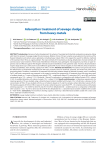
Adsorption treatment of sewage sludge from heavy metals
Статья научная
Introduction. Because of urban development the volume of municipal and industrial wastewater are growing. Along with them the amount of sewage sludge (SS) also increases. Millions of tons of SS are currently accumulated on the territory of the Russian Federation and contain various pollutants, including heavy metals (HM). In this regard, the search for effective methods of SS treatment from HM is an urgent problem. The main methods of SS treatment are drying, dehydration, thermal methods, UV and microwave wave treatment. These kinds of disinfection eliminates many pathogenic microorganisms, but they are quite expensive and not effective against HM. Reagent methods include SS disinfection with quicklime (CaO). However, decontamination requires large doses (up to 30%) and it is also ineffective against HM. Humic-mineral reagent are more effective, they are based on crushed caustobiolites, their cleaning capacity from HM is 19–87%. Methods and materials. The authors have previously shown the effectiveness of wastewater treatment from HM using sorbents based on dolomite, quartzite, and waste from mining and processing plants. Therefore, a method for SS treatment from HM using sorbents based on dolomite, humates, and CS containing CaCO3 and humic compounds was proposed. In this regard, a method was proposed for SS treatment from HM using three types of sorbents based on: 1) waste of thermal power plants (TPP) – conditioned sludge (CS) containing CaCO3 up to 68% and humic compounds up to 12% – sorbent 1 (S1); 2) dolomite – Mg and Ca carbonate in a composition with sodium humate (25%)– sorbent 2 (S2); 3) modified dolomite with sodium humate (1%) – sorbent 3 (S3). Results and discussion. In laboratory experiments, the cleaning capacity of SS was studied using a dolomite-based sorbent modified with humate (1%). In field tests, a decrease in the concentration of HM in SS was studied with the use of sorbents based on CS and the complex sorbent dolomite-humate (75:25). The cleaning capacity of SS from HM increases in the series: sorbents based on waste from TPP – CS containing CaCO3 and humates (cleaning capacity E = 4.8–48.6% for dried SS and 29.3–53.3% for dehydrated SS) < sorbent based on a composition of dolomite with humate (E = 65.1–92.1% for dried and 56.6–89.4% for dehydrated SS) < a dolomite-based sorbent modified with humate (E = 90.8–99.9%). Conclusions. The maximum cleaning capacity is shown by a dolomite-based sorbent coated with a nano- and micro- sized layer of sodium humate.
Бесплатно
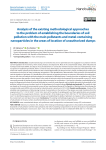
Статья научная
Introduction. Unauthorized dumps are territories that are not permitted and not equipped in accordance with the current legislation of the territory, where waste products are disposed of. Most of the unauthorized dumps, both industrial and municipal solid waste (MSW), are objects of accumulated harm. In connection with the increase in the use of nanoparticles of various genesis in engineering materials, there is a need to assess their impact on environmental components and human health. One of the main marker substances that determine the ecotoxicological effect of dumps are heavy metals, including those entering the environment in the form of metal-containing nanoparticles. Their identification, determination of the processes of horizontal and vertical migration of pollutants (P), identification of the intensity of negative processes are necessary information for making decisions on the choice of methods and technologies for recultivation of disturbed areas. Currently, there are no legislative acts (LA) that take into account the specifics of such objects in the study of territories within the framework of environmental surveys (ES), which necessarily precede the implementation of project documentation for recultivation. A vital task is to develop a methodological approach to diagnosing the state of territories disturbed as a result of waste disposal, and to reliably determine the boundaries of soil pollution, taking into account modern trends in the development of nanotechnology. Methods and materials. The analytical study was based on the results of environmental surveys at four unauthorized dumps of the Republic of Bashkortostan (three dumps for municipal solid waste (MSW) and one dump for industrial waste), carried out in 2019–2020. Results and discussion. A study of the reliability and completeness of determining the level of soil pollution in the territory of the dumps was made. Deviations from the requirements of СS 11-102-97, GOST 17.4.3.01-83 in terms of the number of sampling points and their spatial location were revealed. It was found that the requirements of Article 1 and Article 80.1 of the Federal Law of 10.01.2001 No.7-FL “On Protection of Environment” on identifying negative environmental changes and establishing the ability of pollutants to migrate to other components of the environment were not taken into account. Conclusions. The existing methodological approaches to establishing the boundaries of soil pollution in the areas where unauthorized dumps are located require revision and specification.
Бесплатно
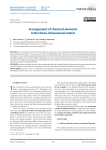
Arrangement of chemical elements in the three-dimensional matrix
Статья научная
It is emphasized in the article that thanks to the discovery of D.I. Mendeleev and the Periodic Table of chemical elements existing for more than 150 years, as well as the international table IUPAC, chemistry has been actively developing and keeps developing. A new model for arranging chemical elements in the form of a three-dimensional matrix has been proposed. This makes it possible to predict new elements with the designation of nuclear masses and the electronic structure of shells. There have been developed new patterns according to the cyclicity (block structure) of horizontal rows and the structure of vertical groups and their physical conception have been specified.
Бесплатно
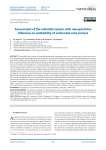
Статья научная
The wettability of a surface of channels filtering liquids and gases under natural conditions of oil and gas reservoirs is one of the parameters that largely determines the filtration. A nature of the filtration channel surface wettability determines a phase permeability, capillary forces and intensity of adsorption at the interface. An ability of the filtration channel surface to be wet by the polar or nonpolar phases of formation fluid and process liquids affects the filtration-capacitive parameters of oil and gas saturated rocks. In this regard, in the development of oil and gas fields, much attention is paid to the study of physicochemical phenomena and processes occurring at the interfaces. An article presents the results of a set of laboratory experiments to study the surface activity of the colloidal system in the form of an emulsion with supercharged nanoparticles. A set of filtration experiments was carried out using the United States Bureau of Mines (USBM) method in order to assess an effect of the emulsion system with nanoparticles on wettability of the surface of oil and gas reservoir rock filtration channels. The research was conducted on rock cores of two oil and gas fields in the Ural-Volga region of the Russian Federation. According to the applied experimental procedure, rock cores were preliminarily maintained under reservoir conditions to give a surface of pore channels the properties close to the natural conditions. After that, the wettability of rocks was assessed by measuring the USBM wettability index before and after filtering the emulsion system with nanoparticles. Analysis of the research results showed that filtration of the emulsion system with high surface activity led to a change in the wettability of rocks from completely hydrophilic (USBM index – 0.60) to completely hydrophobic (USBM index – minus 0.32). The research results allowed to conclude that there is a high potential for application of emulsion systems with supercharged nanoparticles to control the filtration of formation fluids and process liquids in natural oil and gas reservoirs.
Бесплатно
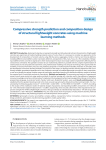
Статья научная
Introduction. Reducing the density, increasing the strength and other physical-technical characteristics of lightweight concretes are urgent tasks of modern building materials science. To solve them, it is necessary to consider new approaches to the development of compositions of cement systems using effective porous aggregates, binders, chemical and mineral additives, including different nanomodifiers (carbon nanotubes, fullerenes, nanoparticles of SiO2, Al2O3, Fe2O3, etc.). The complexity of designing modified cement concretes is largely due to their multicomponent nature and a large number of parameters affecting the key characteristics of material. The qualitative solution of such multicriteria problems is possible with the complex implementation of rational physical and computational experiments using mathematical modeling and computer technology. New opportunities for modeling of structure formation processes and predicting properties of multicomponent building materials are emerging with the development of machine learning methods. The purpose of this study is to develop machine learning algorithms that can efficiently establish quantitative dependences for the compressive strength of modified lightweight concretes on their composition, as well as to identify the optimal variation ranges of prescription parameters based on the obtained multifactor models to achieve the required level of controlled mechanical characteristic. Methods and materials. The processing and analysis of experimental research results were carried out using modern methods of machine learning with a teacher used in the problems of regression recovery, knowledge extraction and forecasting. To implement the developed machine learning algorithms, libraries in the Python programming language, in particular NumPy, Pandas, Scikit-learn, Matplotlib, Seaborn, were used. Results and discussion. It is established that the gradient boosting model is the most accurate type among the obtained machine learning models. It is characterized by the following quality metrics: R2 = 0.9557; MAE = 2.4847; MSE = 12.7704; RMSE=3.5736; MAPE = 11.1813%. According to the analysis of this multifactor model, the optimal dosages of pozzolanic and expanding modifiers amounted to 4.5–6.0% and 6.0–7.5% of the binder weight (Portland cement + modifier), respectively, which ensured achievement of the required level of compressive strength (40–70 MPa) of lightweight concretes at the age of 28 days at material density reduced by 3–10% (the range under consideration is 1200–1900 kg/m3). Conclusions. Thus, the study results show the prospects of using machine learning methods for design compositions and predicting properties of multicomponent cement systems.
Бесплатно
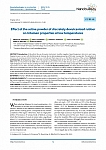
Статья научная
Introduction. In the article the use of powder elastomeric modifier capable of rapid breakdown into micro- and nanofragments upon contact with hot bitumen to improve the low-temperature properties of bitumen is presented. The indicators of resistance to cracking are determined by various methods and their dependence on the thermal history of the samples. Methods and Materials. At temperatures up to –36оC the oscillatory rheological tests (4-mm DSR test) of RTFO-aged samples of bitumen BND 60/90 and modified binder (MB) which contain the active powder of discretely devulcanized rubber (APDDR) produced by high-temperature shear-induced grinding from the crumb rubber of worn tires have been conducted. MB was prepared by mixing bitumen (3 min; 160оC and 600 rpm) with 12.5 wt.% APDDR. Results and Discussion. The effect of the test parameters on the rheological parameters has been studied. Structural transitions in bitumen and MB by methods of differential scanning calorimetry (DSC) and the cracking temperature of the same samples in static conditions in the ABCD test were detected. It is revealed: a decrease in the temperature of actual cracking of the MB sample compared to bitumen. Conclusion. It is shown that APDDR as a modifier affects the structure of bitumen and reduces the temperature sensitivity of bitumen to external influences.
Бесплатно
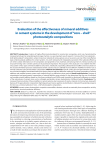
Статья научная
Introduction. Creation of highly efficient photocatalysts for construction composites, which are characterized by increased activity and an extended spectral range of action, is a very important area of research. It is known that “core (substrate) – shell (photocatalyst)” compositions, where mineral raw materials of various genesis can act as carriers, are one of the most effective types of photocatalytic additives for cement systems. It is worth noting that for integrated assessment of the substrate efficiency, we need to obtain information on the composition and properties of raw materials used among which its chemical activity and structure-forming role in cement systems are of paramount importance. The purposes of this study are (1) to establish the influence pattern of four types of mineral additives (silica fume, metakaolin, expanding sulfoaluminate modifier and microcalcite) on the structure formation processes of plasticized cement systems and (2) to identify the most effective modifiers for further use as mineral substrates in the photocatalytic compositions. Methods and materials. Specific surface area and granulometric composition of mineral modifiers were determined by the Kozeny-Karman and laser diffraction methods. The phase composition of mineral additives and modified cement systems were studied using X-ray diffraction phase analysis. Results and discussion. Features of mineralogical and granulometric compositions of mineral additives were revealed. It was determined that the use of individual and complex mineral additives based on silica fume, metakaolin and ESAM made it possible to directionally influence on content of the main phases of cement stone such as ettringite, portlandite, calcium hydrosilicates of different basicity. Conclusions. The increased chemical activity of these modifiers in cement systems, due to presence of reactive minerals in the structure, along with features of the granulometric composition (high dispersity and narrow particle size distribution), indicated the potential prospects for their use as mineral substrate in “core – shell” photocatalytic compositions.
Бесплатно
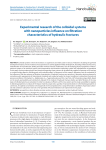
Статья научная
Colloidal systems in form of emulsions or suspensions are widely used in various of industries including oil-gas fields development industry. Invert emulsions and suspensions are actively applied in fields development, including enhanced oil recovery, intensification of oil production, drilling and wells workover. Results of laboratory tests for studying physical properties of heterogeneous systems as an emulsion system with nanoparticles and emulsion-suspension system with nanoparticles are presented in this paper. Having unique physical and chemical properties these systems can be effectively applied in upstream of oil and gas as a water-limiting agent or blocking pack with reversible effect. In framework of this research, laboratory tests for evaluation of the influence of the new systems on filtration characteristics of hydraulic fractures are carried out. Laboratory tests are planned in accordance with requirements of international standards and conducted under the closest conditions to subsurface thermal and pressure conditions of formations STyr Abdylovskoe, SBASh Yugomashevskoe and YuS-2 and YuS-4 of Tortasinskoe oil-gas fields. Based on the results, permeability and conductivity indexes of the models of hydraulic fractures before and after filtration of the new types of colloidal systems are calculated. In order to evaluate an efficiency of the new systems and to study a possibility to regulate its blocking properties an analysis of the impact made by a type and a quantity of nanosized solids on to the blocking properties is carried out. An optimal concentration of nanoparticles in the compositions for a range of formation conditions of particular carbonate and sandstone subsurface reservoirs of oil-gas fields of Russian Federation are represented in this paper.
Бесплатно
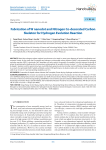
Fabrication of W nanodot and Nitrogen Co-decorated Carbon Skeleton for Hydrogen Evolution Reaction
Статья научная
Metal dots-nitrogen-carbon catalysts have become a hot topic in recent years because of special coordination environment. Herein, for the study the W nanodots and nitrogen co-decorated carbon skeleton (W@NC) was prepared for hydrogen evolution reaction (HER). In particular, NaCl templates not only restrict the growth of nanodots, but also improve the purity of phase. By optimizing the feeding ratio of ammonium metatungstate, W nanodots (the size is about 1.2 ± 0.6 nm) dispersed well on N-doped C skeleton, and this special structure could effectively promote electron transfer and ion diffusion during HER process. As a result, the optimized W@NC hybrids exhibited excellent HER performance in alkaline media with a rather low over-potential (228 mV at 10 mA cm–2) and outstanding durability over 10 h.
Бесплатно
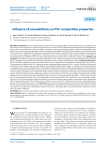
Influence of nanoadditives on PVC composition properties
Статья научная
Introduction. In this scientific article a scheme of the no synergistic effect is observedion process is considered. It has been shown that to slow down or suppress the main process occurring in the condensed phase and determining the formation of gaseous fuel several methods can be used: addition of polymers with increased thermal stability; addition of nanoadditives that reduce the amount of gaseous degradation products; introducing nanoadditives that affect the heat capacity or thermal conductivity of the system, thus changing the thermophysical characteristics of the polymer material. At the same time reduced reaction speeds, occurring in the gas phase and supporting the combustion process, can be achieved through reduction of the concentration of combustible gases and inhibition of the reactions responsible for the branching of the combustion chain process. Methods and materials. The composition and physical properties of kaolin are given. Kaolin monocrystal is a two-layer aluminosilicate containing water of hydration and consisting of chemically bonded layers of silicon dioxide and hydrated alumina. Results and discussion. We have studied the dependence of the attenuation time of a PVC composition on a composition containing from 3 to 10% kaolin. The introduction of kaolin into the PVC compound has led to decrease of decay time from 4.5 to 1 seconds. The effect of the amount of plasticizer on the oxygen index has been studied. We used dibutoxyethyl adipate (DBEA) as a plasticizer. It has good polymer compatibility and is environmentally friendly. The possibility of reducing the content of dibutoxyethyl adipate in the basic formulation of the original plasticate I40-13A by increasing the amount of calcium carbonate was studied, then the performance properties of the resulting compositions were studied. The content of PVC and other components in the basic recipe remained unchanged. Analysis of the data showed that for plasticization of 62% wt PVC contained in I40-13A, 20% wt DBEA is sufficient, while the filler content can be increased at least twice. The oxygen index (OI) value at a component ratio of 20% DBEA + 13.56% CaCO3 increases by 4 OI units and becomes equal to 29.1%. The dependence of the oxygen index of PVC compound on the composition containing from 5 to 20% kaolin has been studied. The results showed that the oxygen index of plastic compound increases significantly with increasing kaolin content. The OI drops with a decrease in the amount of the introduced, and it remains unchanged with its increase. Thus, the optimal content is 15%. Conclusion. Thus, kaolin is a promising, inexpensive and environmentally friendly filler for PVC materials, which effectively reduces their combustibility. The same effect is achieved by increasing the content of calcium carbonate in the original PVC compound formulation. However, no synergistic effect was observed while mixing kaolin and an excess of calcium carbonate.
Бесплатно
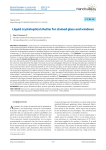
Liquid crystaloptical shutter for stained glass and windows
Статья научная
Introduction. Liquid crystal as a nanomaterial has found application in science, engineering and technologies. The unique physical properties of liquid crystals make them sensitive to external influences. The article presents the results of an experimental study of the flexoelectric effect in a liquid crystal, when shear deformations occur, thin layers of which can serve as an optical shutter for the stained glass windows of buildings. Materials and methods. Nematic liquid crystals with a homeotropic orientation of molecules 10÷100 μm thick were used by the birefringence method. Shear frequency 1 kHz. Methods. The experimental cell was assembled from two glass plates in the form of a flat capacitor, spacers were placed between the glasses, which set the sample thickness. A source of shear vibrations was located on the side of the microscope stage, which was connected to the LC cell using a thin waveguide. Results and discussion. According to the geometry of the problem, the director is headed vertically parallel to the Z axis, the velocity vector of the plate vibrations is horizontal along the X axis. The orientation of the liquid crystal molecules in the volume is characterized by the angle θ. An elastic-viscous wave propagates between the moving and stationary substrates of the LC cell, which leads to a perturbation of the initial homeotropic orientation of the director field. The dependences of the first and second harmonics of the shear-induced EMF, as well as the optical signal, on the plate oscillation speed are obtained. They have a threshold nature of occurrence at a critical speed υc~8 mm/s, while the liquid crystal molecules are oriented at an angle θс. The temperature dependences of EMF harmonics far from the nematic – isotropic liquid phase transition showed that when approaching the phase transition, the regression of the signal U1ω stops, and then its value increases up to the temperature transition of the nematic – isotropic state TNI. The magnitude of the optical signal I2ω/Io(T), approaching the phase transition, increases, which is explained by the increase in the amplitude of the director oscillation Θd. Conclusion. The article considers the flexoelectric effect observed in thin layers of nematic liquid crystals with homeotropic orientation of molecules placed between two glass plates. The occurrence of the effect has a threshold character, the critical strain rate is about 8 mm/s. The conditions and parameters of the effect (shear amplitude, sample temperature) on a condenser cell for various liquid crystals are considered. It is proposed to use the results obtained to create an optical shutter (shutter) for stained glass windows or windows of buildings and structures.
Бесплатно
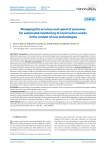
Статья научная
Introduction. Existing automated construction inspection technologies do not allow the user to select the level of detail. At the same time, in the context of the use of nanotechnology, there is a growing need to expand the capabilities of monitoring and control of construction projects. The aim of the research is to develop, implement software, and validate a technology for controlling the speed and accuracy of constructing three-dimensional models from dense point clouds for automated monitoring of construction works. Materials and methods. The research is based on the methodology of non-binary data trees, including the method of constructing octant trees. An unmanned aerial vehicle with an aerial laser scanner, a ground-based scanning total station, and specialized software were used, including the web application “Management System for Monitoring Construction Works on Objects that have undergone state expertise” developed with the participation of the authors. Results and discussion. In the course of the study, a technology was developed and implemented in software that allows the user to select the required balance between accuracy, degree of detail of monitoring and control data for construction work and time costs and computing power requirements. The comparison is made between a construction project, presented in the form of a building information model, and a three-dimensional model of a real object, obtained from a dense point cloud. The degree of comparison accuracy is set by choosing the level of octrees used. By default, the web application uses level eight. However, in the early stages of construction, when the geometric parameters of a dense point cloud deviate significantly from the design boundaries, the ninth, tenth and other levels can be used. In this case, the accuracy and degree of detail increases. Positive and negative deviations are visualized in red and blue colors, respectively, which allows the user to monitor and control the progress of work at the site. Conclusions. The developed technology can be used by customers and other decision makers to control and monitor work.
Бесплатно
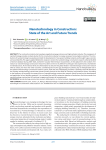
Nanotechnology in Construction: State of the Art and Future Trends
Статья научная
The construction industry has long been regarded asenergy-intensive and high pollution industry. The emergence of nanotechnology provides an ideal solution for the construction industry to energy saving and consumption reduction. The introduction of nanotechnology has greatly promoted the development of new green building materials and brought huge economic and social benefits. This paper applies bibliometric analysis to review the nanotechnology-construction research collected by Web of Science database during 2000–2020, and further visualize their literature characteristics. At the global level, the number of literatures on nanotechnology-construction research has been on the rise in 2000-2019, although it has experienced a small decline in individual years. At the national level, the United States has become the global leader in nanotechnology-construction research with 63 articles, far more than other countries. Considering the income gap, developed countries play an indispensable role in the global nanotechnology-construction research system, while the role of developing countries is relatively weak. We found that the existing nanotechnology-construction research mainly focused on the fields of chemistry and materials science. According to the frequency of keywords, the research focus of nanotechnology-construction research mainly focused on the development and application of new building materials. It is concluded that with the extensive attention of researchers, the future research on nanotechnology-construction will continue to appear and increase at increasing rate.
Бесплатно
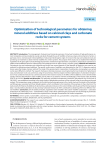
Статья научная
Introduction. The management of physical and chemical processes of structure formation of high performance cement composites can be provided at several scale levels through the use of modifiers of various nature and mechanism of action, in particular, micro- and nanoscale mineral additives of natural and technogenic origin. It is known that clays and carbonate rocks are promising raw materials to obtain mineral modifiers for cement systems. The purpose of this study was to establish the influence regularities of the prescription and technological parameters (material and granulometric compositions, temperature calcination) to obtain mineral additives based on calcined clays and carbonate rocks on their activity in cement systems. Methods and materials. Polymineral clays and carbonate rocks (dolomite and chalk) from several deposits of the Republic of Mordovia were used as raw materials for obtaining mineral additives. The specific surface area of modifiers was determined on the PSX-12 dispersion analysis device using the Kozeny-Carman method. The study of the granulometric composition of sedimentary rock powders was carried out by laser diffraction method. The research of physical-chemical processes occurring during the heat treatment of polymineral clays and carbonate rocks was carried out using the synchronous thermal analysis method. Optimization of calcination temperature of clay-carbonate mixtures was carried out based on the research results on the effect of their additives on the cement binder activity with the determination of the modifier activity index in accordance with the methodology of the Russian State Standard GOST R 56178-2014. Results and discussion. The optimum calcination temperature, located for polymineral clays in the area of 500–800оC, was established according to the study results of dehydration processes of clay minerals using the synchronous thermal analysis. This temperature range corresponds to the initial restructuring processes in the crystal structure of minerals of the kaolinite and illite groups, associated with their dehydroxylation, which contributes to the transition of these phases to the active form. The study results of influence of additives of calcined clay-carbonate mixtures on the cement binder activity proved the thermal analysis data. It was found that calcination of clays and clay-carbonate mixtures at 700°C contributes to obtaining of the most effective mineral modifiers. Conclusions. On the totality of studies, regularities were revealed in the system “modifier composition – calcination temperature of sedimentary rocks – mixed binder activity”, which allow optimizing the prescription and technological parameters for obtaining mineral additives to achieve the required level of strength characteristics of cement composites.
Бесплатно
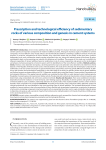
Статья научная
Introduction. Active mineral additives that allow controlling the structure formation processes and properties of cement systems are important components of modern modified concretes. Among the numerous types of modifiers for cement composites, the most effective ones include siliceous and aluminosilicate additives containing a significant amount of nanoscale particles, in particular, nanoparticles of silicon dioxides, clays, aluminum oxides and iron oxides. At the same time, common sedimentary rocks, such as diatomites, trepels, opokas, polymineral clays, etc., along with industrial wastes (silica fumes, fly ashes, metallurgical slags) can be promising raw materials for obtaining such modifiers. The purpose of this study was to establish the influence regularities of mineral additives based on sedimentary rocks of various composition and genesis on the technological and physico-mechanical properties of cement systems with the identification of the most effective modifiers. Methods and materials. Siliceous rocks (diatomite and opoka), calcined polymineral clays and carbonate rocks (dolomite and chalk) from several deposits of the Republic of Mordovia were used as mineral additives. The study of the chemical and mineralogical composition of sedimentary rocks was carried out using X-ray spectral fluorescence spectrometry and X-ray powder diffraction methods. In addition to the chemical and mineralogical composition, at the initial stage of the study, the specific surface area of mineral additives and Portland cement was determined on the PSX-12 dispersion analysis device using the Kozeny-Carman method. Prescription and technological efficiency of the applied mineral modifiers was evaluated by their effect on water demand, water-holding capacity, flowability of cement paste and mixed cement binder activity. The physical and mechanical characteristics of cement systems were determined using standardized and well-known authorial methods. Results and discussion. There were established correlation dependences between indicators of water demand, water-holding capacity, flowability of cement systems and specific surface of mineral additives used. In addition, relationship between the activity index of the studied modifiers and the content of silicon dioxide in their composition was revealed. Conclusions. According to the totality of the conducted studies, diatomite, opoka and calcined polymineral clay were identified as the most promising types of mineral additives. The increased effectiveness of these modifiers in cement systems is due to the peculiarities of their chemical and mineralogical composition, in particular, the presence of active silica-containing components (reactive minerals with an amorphized structure) such as opal-cristobalite-tridymite phase in diatomite and opoka as well as products of partial thermal destruction (dehydroxylation) of minerals of kaolinite and illite groups in the calcined polymineral clay.
Бесплатно
Статья научная
Introduction. In the article we analysed the technology for producing silicon from rice husks. The analysis showed that the production of polycrystalline and amorphous silicon based on rice waste in the form of rice husk solves the simultaneous disposal of rice waste. Rice husk processing produces valuable organic products, and the residual solid waste mainly contains silicon, carbon and other trace metal elements. Therefore, obtaining silicon and silicon-containing materials from rice husk is relevant. Methods and materials. Various methods for obtaining silicon from rice husk are given. Among them, the methods of chlorination and sublimation were chosen, and experimental installations were assembled to conduct the experiment. The object of study was samples obtained from rice husks of Uzgen rice in the Kyrgyz Republic. Results. The composition and structure of rice husks for the production of crystalline silicon were studied. Lime milk was used to purify toxic chlorine-containing gases in the air of the working area and atmospheric air. The condensing system, designed to capture volatile chlorides, has two receivers. In the first receiver at a temperature of 60°C, condensation of iron, aluminum and magnesium chlorides occurs. It has been established that highly volatile silicon (IV) chloride (SiCl4) at a given temperature remains in the gaseous phase and is completely distilled off in the next receiver of the refrigerator. This indicates that the silicon is in the form of SiCl4 (60°C) and condenses only at a lower temperature in the next receiver. The data obtained indicate that when the temperature rises to 200°C, the process of chlorination of metal compounds initiates. The optimal conditions for maximum extraction of metals and silicon tetrachloride from rice husk were identified: temperature 500–550°C and time 120 minutes. Non-volatile chlorides of calcium, sodium, potassium and other elements form a floating mixture at 450°C. During the reaction, metal chlorides harden and settle on the cold walls of the reactor. Therefore, at this temperature there is not enough heat to maintain them in a gaseous state, and they condense to form solid precipitates. Lime milk containing CaO – 130 g/dm2 is a very effective and cheap means for purifying toxic chlorine-containing gases in the air of the working area and atmospheric air. At high temperatures (1050–1100°C), it is possible to activate chemical reactions between the carrier gas (hydrogen) and silicon chloride (SiCl4), which promotes the decomposition of SiCl4 into components, including silicon and hydrogen chloride, and also provides certain conditions for the formation and deposition silicon crystals. Conclusion. A technology for producing polycrystalline silicon by chlorination from rice husks of Uzgen rice of the Kyrgyz Republic has been studied and developed.
Бесплатно

Resource-saving nanotechnologies in waste water treatment
Статья научная
This paper examines the prospective field of nanotechnology development in the area of wastewater treatment and water processing. The introduction showed (no need for comma) that the Russian problem is not the lack of water – but its quality. Water treatment is needed to prevent water facilities from pollution. Self-cleaning methods cannot withstand the massive impact of pollutants, some of which are unknown for their natural reproduction processes. The degree of purification depends on the concentration of the pollution and the content of different substances within it. The use of nanotechnologies in effluent neutralization (EN) processes will allow removing insoluble sludges, wastes of chemical industry, and harmful microorganisms. Methods and materials. This work presently uses analytical methods to study nanotechnologies. Nanofiltration and membrane methods are frequently used in wastewater treatment. Methods such as arc charge, ablation, and gas-phase deposition are applied to obtain carbon nanotubes. Results. The authors describe promising carbon nanomaterials for production of membranes used in purification/decontamination/ desalination of water. The new generation of membranes for filtering, disinfection, and desalination have been shown. These include graphene and carbon nanotubes which present absolutely new nanomaterial. Discussion. It was revealed that such membranes are characterized not only by a high water percolation rate, but also by extraordinary selectivity. Such membranes are particularly promising in the field of biomedicine, as large membranes are necessary for the nanofiltration and desalination processes. Conclusions. This paper examines new ecological and resource-saving technologies making possible improved research, industrial and commercial activities (which by means of practical implementation of inventions will lead to improved products), technologies and organizational decisions. One of the most promising areas for the development of nanotechnologies applied in waste water treatment is the advancement of membrane technology employing innovative materials, specifically graphene and carbon nanotubes.
Бесплатно
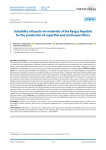
Статья научная
Introduction. Literature analysis and patent search revealed that basalt rock and its fibers have exceptional physical and technical characteristics and alongside abundant raw material reserves. Based on this, the use of basalt rocks and their fibers as a material for the development of advance composite materials with high performance characteristics is a promising direction. Diverse technological fields and economic sectors, as well as various material requirements, necessitate a spectrum of systems, compositions, and properties for basalt and its melts, whether for generating superthin or continuous fibers. Methods and materials. The chemical and mineralogical compositions of some basalt rocks from deposits in the Kyrgyz Republic were studied to determine their suitability for production of superthin fibers and continuous fibers. The acidity modulus and fusibility modulus were determined by calculation based on the chemical composition of basalts of the Kyrgyz Republic. Among them, the quality of basalts from the Suluu-Terek deposit and basalts from the Toru-Aigyr deposit fully meets the requirements for the quality of raw materials for creating the production of basalt superthin fibers (BSF) and basalt continuous fibers (CBF). In the research we used physical and chemical analysis methods to determine the chemical and mineralogical composition of basalt. By calculating the acidity and fusibility modulus of basalt raw materials from the Kyrgyz Republic, as well as comparing them with relevant standards, their suitability for the production of basalt superthin fiber (BSF) and basalt continuous fiber (CBF) was established. The object of the study was the basalts of the Sulu-Terek deposit. Results of the study include an analysis of the chemical and mineralogical compositions of certain basalt rocks from deposits in the Kyrgyz Republic in order to assess their suitability for the production of superthin and continuous fibers. The acidity modulus and fusibility modulus of basalts of the Kyrgyz Republic were determined by the calculation method. Among them, it was revealed that the quality of basalts from the Suluu-Terek deposit and basalts from the Toru-Aigyr deposit fully meets the requirements for the quality of raw materials for the production of basalt superthin fibers (BSF) and basalt continuous fibers (CBF). Conclusion. The suitability of basalt rocks from various deposits, especially Suluu-Terek, Taldy-Bulak and Kashka-Suu, was confirmed, with recommendations for use. The results also highlight the importance of compliance with standards when selecting deposits and setting production parameters.
Бесплатно

